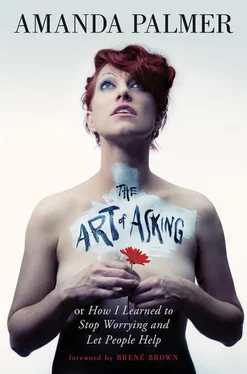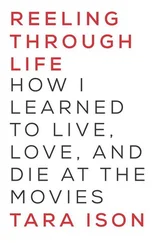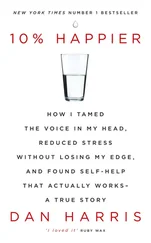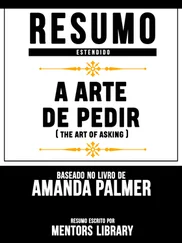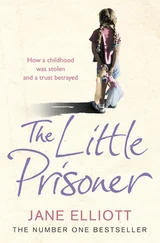I delivered the second art-sitting in Perth. The backer’s name was Yana, and it wasn’t until I met her at my public concert the night before that I realized I knew her from Twitter. We’d been casually communicating for years… and I realized she’d brought food backstage to a show a few years before.
Yana’s hard to miss. She was born with achondroplasia. In her late twenties, she’s four foot six inches tall, and she’s undergone ten operations to lengthen her arm and leg bones. After she gave me a tour of her folks’ cozy suburban Australian house and the backyard jungle where she’d adventured as a kid, we all sat down for a home-cooked feast, during which I chatted happily with her younger brother Sebastian and her French mum and British dad about everything from homesickness to the new Australian prime minister, Tony Abbott (nobody was a fan). I felt very at home; they were such a loving, warm family. And I was so impressed by Yana, how confident, self-possessed, and funny she was. She’d studied music business in college but was working shifts in a hospital, and she seemed determined to not let her condition get in the way of her happiness—she exuded positivity.
After the family meal, Yana bundled up a canvas, blankets, and brushes into boxes that I helped carry across a street and a soccer field. She had it all planned out: she wanted to pose nude in the park where she’d played as a child. I told her that if we got arrested, it would probably be the most cred-building event in my life since I was jailed in Amsterdam for doing a ninja gig in the wrong place at the wrong time.
Yana wasn’t a natural exhibitionist, but as soon we settled into a shady gazebo near the playground with nobody around, she took a deep breath and shed her clothes. I picked up a paintbrush.
Her body was a beautiful landscape of snow-white skin, her legs and arms covered in constellations of scars from her surgeries. As I focused on sketching her outline, I felt a quiet, profound sense of honor. I’m an amateur painter, and completing a passable likeness took two hours, which included a couple of close calls in the indecent exposure department. One old man wandered over to us and asked us what we were doing, as Yana dived under the blanket.
We’re art students , I lied earnestly.
Yana shared the stories of her life: about how she was constantly ill as a result of her condition, and about Jeff, her best friend, who had turned her on to my music years ago.
We were both hospital babies , she told me. We never had to justify ourselves to each other .
Jeff had died the month I launched my Kickstarter. Yana had bought the art-sitting as a sort of parting gift to his memory. I didn’t ask where she got the money.
Everybody always looks at me , she mused, as another passerby wandered too close and she grabbed the blanket… but never for the reasons I want .
I kept messing up her eyebrow.
Everybody I know , I said, especially the performers, has such a complicated relationship with being looked at. But seriously, I cannot imagine what yours is like .
It’s hard , said Yana.
I erased and redrew, thinking about how we judge one another. Was I trying to make her more beautiful? I shook off the thought and kept trying to get her left eyebrow to at least look like an eyebrow.
• • •
I’d sold thirty-four Kickstarter house parties for $5,000 each—anywhere in the world—and promised to deliver within eighteen months. I laid out some guidelines, having already sold and successfully delivered a handful of them as part of my Amanda Palmer Goes Down Under record. No more than fifty people. They could happen anywhere (outdoors, indoors, anywhere in the world, and I’d pay my way there) but they couldn’t be publicly promoted shows. The package included about $1,000 worth of merchandise as well: the vinyl, the high-end art books, the record player, and so on.
Very few people could afford the price tag of the party, so only about five parties were sold to single individuals; the rest were impressive efforts of community trust. Facebook groups started, volunteers coordinated to pool funds, find locations, and whip the parties into shape. From South Africa to Israel to Canada to Germany to Australia, total strangers trusted one another. When I showed up at the parties, there were often three hosts: the person who volunteered their house, the person who volunteered to throw down the five grand and trust that forty-nine people would kick in $100 each, and the person who dealt with potluck logistics. These hosts often became friends with one another through the very act of combining their efforts. It was an innovation in collectivist fandom that I’d never seen before.
Eric, my manager, wears about eighteen different hats—including making himself personally available on email and Twitter to thousands of fans who had questions about the Kickstarter. He was in charge of being the liaison for all thirty-four house party contacts. He juggled my travel schedule, along with my booking agent, to make sure I could hit all thirty-five cities while I toured—hopefully not having to zigzag or backtrack too much. It was an exercise in organizational Zen. (At the time this book goes to print, I’ve delivered thirty-three. The last one, in South Africa, remains undelivered. They’ve been really understanding… they’ve even uploaded a song-video to YouTube about how much they’re looking forward to it.)
• • •
Delivering the house parties felt like cresting a peak of crowdsurfing or couchsurfing. As I bounced back and forth on a regular basis between playing for a crowd of 1,500 in a standing-room-only theater one night and fifty people in a living room the next, I realized what the difference really meant.
An official show in a club or a theater is repetitive work: soundchecks, dressing rooms, testing lights. The environment is set up to do business, not art: security checkpoints; cash registers ringing open and slamming closed; bored bartenders loudly scooping ice into drinks, waiting for you to finish your screaming and swearing so they can clock out.
At a house party, everybody improvises and cobbles together a space; there’s nobody who doesn’t want to be there. Dogs and kids run freely, curfews don’t exist, strangers become real friends under the magical umbrella of a unique, shared experience. The music is important—I always play for at least an hour or two—but it isn’t the absolute center of the evening. Nor am I, the so-called star, the center. I slink back and watch as people warm to and bond with each other.
Throughout the post-Kickstarter year I got better and better at the house parties, which took place in cleared-out wheat barns in rural Germany, illegal basement speakeasies in London, suburban backyard barbecues all over the States, the UK, and Australia. Something surprising happened every night, and I started to enjoy the feeling of absolute uncertainty. No matter what happened, I twittered, instagrammed, and blogged the results. The crowd followed along.
The Tel Aviv house party featured a pole dancer and a rendition of one of my songs sung in Hebrew by the entire group—they’d all rehearsed a translation. On a remote hillside in Oslo, the whole party engaged in a game where everybody took turns drawing on an easel provided by the host, and one by one described the best and worst things about the various Nordic towns they hailed from. I got a pretty thorough education in Norwegian-Swedish rivalry that night, along with a great massage from a bearded man who, hours later, set up a DJ tent and blasted music into the dawn as the fire pit died down.
At a party in Nashville, a girl asked her parents’ permission to graffiti the outside walls of their guest house; fifty people attacked the huge structure with spray-paint cans. A few weeks later, a house party in Chicago picked up the theme and we spray-painted an entire garage.
Читать дальше
